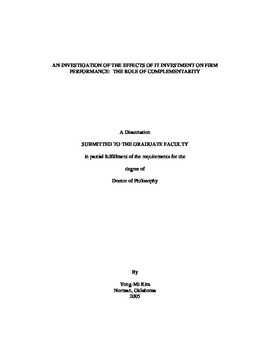| dc.contributor.advisor | Zmud, Robert W., | en_US |
| dc.contributor.advisor | Miranda, Shaila M., | en_US |
| dc.contributor.author | Kim, Yong-mi. | en_US |
| dc.date.accessioned | 2013-08-16T12:19:55Z | |
| dc.date.available | 2013-08-16T12:19:55Z | |
| dc.date.issued | 2006 | en_US |
| dc.identifier.uri | https://hdl.handle.net/11244/919 | |
| dc.description.abstract | The concept of complementarity has been introduced into IT-based firm performance research in order to address inconsistent magnitudes of the impacts from IT investments across studies. This dissertation seeks to understand the scope of IT investment complementarities, to examine the different ways in which different complementarities impact the payoff from an IT investment, and to empirically test the effects of complementary investments in the context of investments in SCM and CRM. The knowledge-based view of the firm (KBV) is employed in order to understand a boundary and different roles of complementarity. The KBV sees organizational capabilities from the aggregation of knowledge into capabilities and the deployment of knowledge assets in the form of capabilities. Knowledge aggregation requires individuals' specialized knowledge (human capital) and the aggregation mechanisms of structural, social, and community capital. The combination of these three forms of capital, together with human capital, constitutes organizational capabilities. Once constituted, the complementary deployment of capabilities is important. Foundational capability must be in place in order for the focal IT investment to deliver value, synergistic capability amplifies the economic benefits of the focal IT investment, and management capability is managers' organizing vision and capability to successfully deploy the focal IT investment. | en_US |
| dc.description.abstract | The research findings show that three forms of structural, community, and human capital have highly significant impacts on firm performance measured by Net Cash Flow, Gross Profit, and EBITDA. Synergistic capabilities and management capabilities are found to be highly significant in moderating between three forms of capital and firm performance measurements. | en_US |
| dc.description.abstract | The data for this study were drawn from secondary data sources: Annual Reports, Press Releases, and news articles. The dependent variables are drawn from COMPUSTAT. The data collection method for the independent variables was a keyword search. The research sampling frame is confined within a single value chain however distinctively different industry categories are represented within this value chain. This sampling strategy yielded a total of 111 firms that had invested in SCM and 45 firms that had invested in CRM. | en_US |
| dc.format.extent | xvii, 212 leaves : | en_US |
| dc.subject | Capital investments. | en_US |
| dc.subject | Information technology Management. | en_US |
| dc.subject | Business Administration, Management. | en_US |
| dc.title | An investigation of the effects of IT investment on firm performance: The role of complementarity. | en_US |
| dc.type | Thesis | en_US |
| dc.thesis.degree | Ph.D. | en_US |
| dc.thesis.degreeDiscipline | Michael F. Price College of Business | en_US |
| dc.note | Advisers: Robert W. Zmud; Shaila M. Miranda. | en_US |
| dc.note | Source: Dissertation Abstracts International, Volume: 66-12, Section: A, page: 4444. | en_US |
| ou.identifier | (UMI)AAI3203278 | en_US |
| ou.group | Michael F. Price College of Business | |
